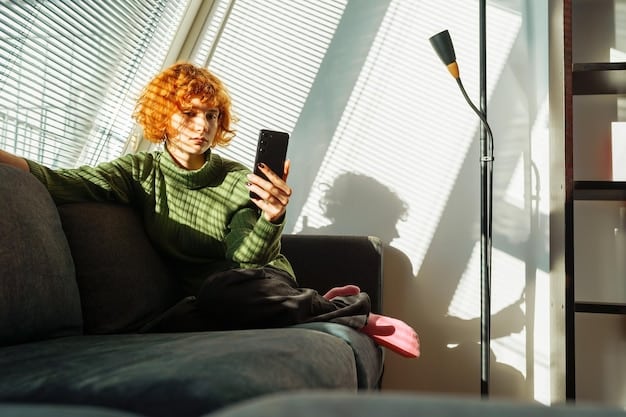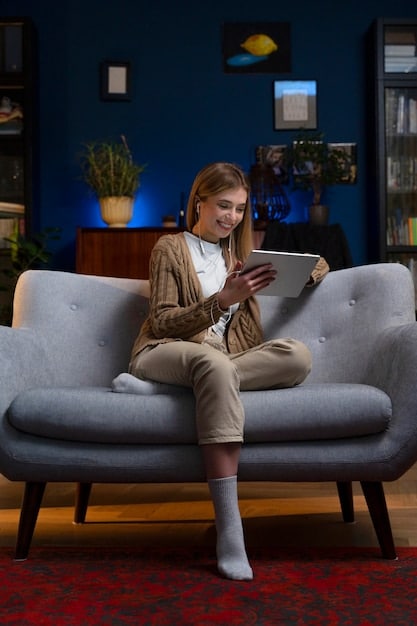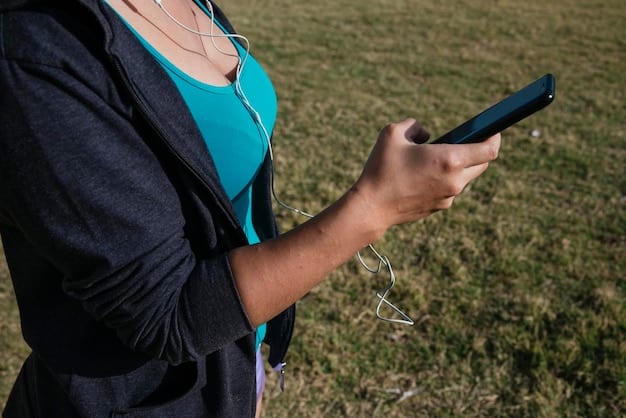Augmented Reality Apps: Try Before You Buy in the US

Augmented reality (AR) apps are transforming the US shopping experience, allowing consumers to virtually try products like furniture, clothing, and cosmetics before making a purchase, enhancing confidence and reducing return rates.
Ready to revolutionize your shopping experience? Augmented reality apps for US shoppers are changing the game by letting you try before you buy, right from the comfort of your home.
What are Augmented Reality Apps?
Augmented reality (AR) apps blend the digital world with our physical surroundings, creating an interactive and immersive experience. These apps utilize your smartphone or tablet’s camera to overlay computer-generated images onto the real world.
In the context of shopping, this means you can virtually “try on” products before committing to a purchase. Let’s delve into how they function.
How AR Apps Work
These apps use sophisticated algorithms to understand the dimensions and environment captured by your device’s camera. This allows for accurate placement and scaling of virtual objects.
AR shopping apps use advanced image recognition and tracking technologies to map the user’s face or environment, enabling realistic virtual try-ons and product placements. Here are some highlights:
- Facial Recognition: Accurately maps facial features for realistic makeup and eyewear try-ons.
- Object Detection: Identifies objects in the scene to properly place virtual items.
- Environmental Understanding: Analyzes the surrounding environment for realistic furniture placement.

AR apps are making shopping more convenient and user-friendly.
Benefits of Using AR Shopping Apps
AR shopping apps offer a host of benefits that can enhance the consumer experience. By allowing users to virtually interact with products, these apps can boost confidence, save time, and reduce return rates. Here’s how.
From furniture visualization to virtual clothing try-ons, the advantages are plentiful:
Increased Purchase Confidence
Seeing how a product looks in your space or on your body before buying dramatically reduces the risk of disappointment. AR apps allow consumers to make more informed decisions.
Reduced Return Rates
When shoppers have a clearer idea of what they are buying, they are less likely to return the product. This saves both the consumer and the retailer time and money.
Time-Saving Convenience
Virtual try-ons eliminate the need to physically visit stores, saving time and effort. Consumers can shop from the comfort of their home, while AR apps enhance convenience.
Popular AR Apps for US Shoppers
Several AR apps are making waves in the US market, each offering unique features and capabilities. These apps cover a range of product categories, from home goods to cosmetics.
Let’s explore some of the most popular options available to US shoppers:
Sephora Virtual Artist
This app allows users to virtually try on makeup products, experimenting with different shades and looks. It’s a perfect way to find the right colors without the hassle of in-store sampling.
IKEA Place
IKEA Place lets you visualize IKEA furniture in your home, ensuring it fits your space and style. It’s a game-changer for home decor shopping.
- Easy to Use: Simply scan your room and drag and drop furniture items.
- Accurate Scaling: Products are accurately scaled to ensure a realistic representation.
- Saves Time: Eliminates the need to guess whether a piece will fit or look good in your home.
Wanna Kicks
Wanna Kicks lets you virtually try on sneakers, so you can see how different styles look with your outfits. A fun and engaging way to shop for footwear.

From cosmetics to furniture, AR apps are revolutionizing how we shop.
How to Use AR Apps for a Better Shopping Experience
To get the most out of AR shopping apps, it’s important to use them correctly. Here are some tips to enhance your shopping experience and ensure accurate results.
Proper setup and usage can make a significant difference:
Ensure Proper Lighting
Good lighting is crucial for accurate object detection and placement. Make sure your environment is well-lit for the best results.
Calibrate the App
Follow the app’s instructions for calibration to ensure accurate measurements and scaling. This will help you get a realistic preview of the product.
Experiment with Different Angles
Try viewing the product from different angles to get a comprehensive idea of how it will look in your space or on your body. Experiment with different angles for the best view.
By following these steps, you can maximize the benefits of AR shopping apps.
The Future of AR in Retail
The future of AR in retail is bright, with ongoing advancements promising even more immersive and personalized shopping experiences. As technology evolves, we can expect to see AR integrated into more aspects of the retail industry.
More innovations are on the way:
Enhanced Personalization
AR apps will become even more personalized, offering customized recommendations based on individual preferences and past purchases. Expect personalized recommendations based on your taste.
Integration with AI
Artificial intelligence will play a larger role in AR shopping, providing intelligent suggestions and helping users make smarter buying decisions. AI will deliver smarter shopping experiences.
Wider Adoption Across Industries
The adoption of AR technology will expand beyond the current product categories, encompassing a broader range of industries and applications. From groceries to automobiles, more sectors will integrate augmented reality. With wider adoption comes more convenience for consumers.
AR is set to transform the retail landscape, creating more engaging and efficient shopping experiences.
Challenges and Limitations of AR Shopping Apps
Despite their many benefits, AR shopping apps also come with certain challenges and limitations. Understanding these drawbacks can help you manage your expectations.
It should be noted, AR apps are not without their limitations:
Accuracy Issues
While AR technology is advancing rapidly, there can still be inaccuracies in object detection and placement. Don’t rely solely on the app for critical measurements.
Dependence on Device Capabilities
The performance of AR apps depends heavily on the capabilities of your smartphone or tablet. Older devices may not provide the best experience. Newer devices may offer improved performance.
Privacy Concerns
AR apps require access to your device’s camera, raising privacy concerns. Always review the app’s privacy policy before using it to protect your personal information.
Awareness of these challenges is essential for a balanced perspective on AR shopping.
| Key Point | Brief Description |
|---|---|
| 📱 Virtual Try-On | Try clothes, makeup, and accessories before buying. |
| 🛋️ Furniture Placement | Visualize furniture in your home using AR apps. |
| ✅ Increased Confidence | Make informed decisions and reduce return rates. |
| 💡 Future Trends | Personalized and AI-integrated AR shopping experiences. |
Frequently Asked Questions about Augmented Reality Apps
▼
Augmented reality (AR) overlays computer-generated images onto the real world using your device’s camera. This allows you to interact with virtual objects in your physical environment, creating an immersive experience.
▼
While AR technology is improving, accuracy can vary. Ensure proper lighting and calibration for the best results. Don’t rely solely on AR for critical measurements.
▼
Most modern smartphones and tablets are compatible with AR apps. Check the app’s requirements to ensure your device meets the necessary specifications for optimal performance.
▼
AR apps allow you to virtually try on products, visualize furniture in your space, and make more informed purchase decisions. This leads to increased confidence and reduced return rates.
▼
Popular AR shopping apps include Sephora Virtual Artist for makeup, IKEA Place for furniture, and Wanna Kicks for sneakers. These apps offer a variety of virtual try-on experiences.
Conclusion
Augmented reality apps for US shoppers are revolutionizing the way we shop, offering a convenient and immersive try-before-you-buy experience. From visualizing furniture in your home to virtually trying on clothes and makeup, these apps enhance confidence and reduce return rates, making shopping more enjoyable and efficient.





